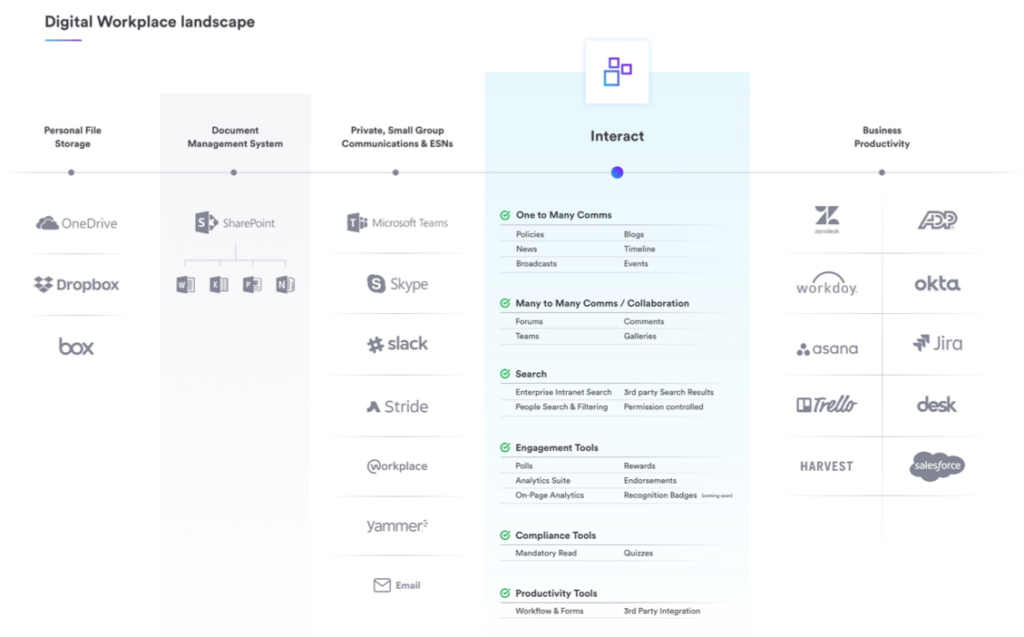Internal communications is arguably more important now than ever before. But despite its fast-paced growth over the past decade, coupled with the dynamic evolution of the technological landscape, the intranet has remained the backbone of in-house communication.
Yet, it’s important to remember that while an intranet achieves a lot of things, there are other internal communication tools available which can support an internal comms department.
In any type of organization, IC departments face several day-to-day challenges: communicating vision and change, engaging employees and instilling purpose across the workforce. A lot of this involves carrying clear-cut messages across to people, and inviting feedback, discussion and reaction.
Internal communication also covers planning, productivity, building company culture, aligning teams and operations. With all these different tasks, it’s so important to get your communication channels right.

So, what are the best tools to use for this type of job? The dizzying array of products available in today’s workplace can feel unmanageable, which is why the intranet can feel a safe haven in comms. This is the organization’s network where messages are relayed and where everyone is connected. So, should the intranet be your go-to mouthpiece?
Yes, and no.
There are times when internal communicators need other means by which to relay their message. While an intranet has many benefits to a business, even the most sophisticated software has its limits.
An intranet is crucial for employees, but it should be viewed as just one vital component of the digital workplace, with additional apps available to work with alongside it. The sign of a good intranet is its ability to integrate with other tools that are also critical for the modern workplace.
For a modern business, there are many different types of communication. And a good internal comms department will realize the best applications out there which can overcome their different IC challenges in a much more effective way.
It’s important to manage these apps carefully, however. It has been estimated that enterprise organizations have access to over 500 applications in the workplace. This overwhelming choice has led to ‘app fatigue’ where workers use the same – and possibly wrong – products for tasks.

Ensuring employees have visibility and access to the best applications is a big challenge for every business. A good intranet can provide this via a single gateway and become your go-to place to get stuff done.
These types of intranets don’t try to compete with tools specifically designed for the job but work as a launchpad to help the worker seamlessly use the right products at the appropriate times.
As an internal communications expert, it’s important to know when it’s best to exploit your intranet’s capabilities and also when to use more suitable products for other types of communications.
From collaboration to engagement, an intranet serves a lot of uses. But it’s important not to completely rely on it for every type of internal communication. Here, we look at the different types of IC challenges that are best met outside of the intranet.
Quick updates
Sometimes, all you need is to drop a quick note to someone, whether it’s asking them to proof a document, a request to move a meeting back or asking them to join you for lunch. Chat tools like Skype or Messenger are great for informal, easy communication.
One-to-ones
While an intranet is great for communicating to the many, there are other products out there that are designed for more private communications. If you’re not carrying out a face-to-face meeting, emails are an obvious option for a confidential chat.

Small groups
With its open environment, intranets are not practical to hold small group chats on. If you’re working on a project with a small group of people, it’s far better to use a tool like Slack to create a space where you can carry out informal chats when you’re not together in-person.
Video calls
An intranet platform will rarely factor in video software, simply because there are other applications that do the job better. Skype, Zoom, Blue Jeans and a whole host of other products are ideal for video conferences, quick calls, and team chats.
Urgent crisis comms
Although an intranet is vital in a crisis, if you need to get notify your workers quickly, you will have to work outside of the intranet as well. Not everyone works behind a desk, so when you have workers in warehouses, depots, outdoors or who are customer-facing, there is limited access to the company intranet. If you need to relay an urgent message which will directly affect them, you will need some kind of SMS service that alerts them via mobile device instantly.
Enterprise Social Networking (ESN)
An intranet has clear limits on the networking it can carry out, which is why organizations should look around if they want to connect in-house with individuals who share similar business interests. Apps like Yammer, Tibbr, and Jive all provide a great area to communicate away from the intranet.
Document sharing
While an intranet is an ideal place for storing official documents and policies, when it comes to project work, there are specially-designed document management software systems around. Sharepoint is a good example of being able to set up libraries for Word, Excel and Powerpoint files.
So how can an intranet help internal communications?

An intranet’s main strengths are legion, which is why it is the centerpiece of the digital workplace. Its role as a way of collaborating, engaging and communicating to the many, make it an IC department’s number one tool in which to build their organization. There are many ways an intranet can help internal comms challenges:
One-to-many comms
The majority of your workers should be connected to your intranet. In terms of presenting policies, sharing news, championing others and sharing blogs, an intranet is the best platform when you need to communicate with the many.
Collaborations
Large group discussions can take place successfully on an intranet, with the help of forums, comments, and galleries. These areas are all powerful devices where large groups can get together to communicate and collaborate. Sending documents, asking experts and sharing experiences are fundamental.
Search
A good search function is essential to productivity – Interact software allows you to use Enterprise Search, People Search & Filtering, 3rd Party Search Results and Permission Controlled Search, which allows you and your employees to find the information you need quickly, resulting in less wasted time.
Engagement
There are many ways to boost engagement among staff. With Polls, Rewards, Analytics Suite, Endorsements, On-Page Analytics and Recognition Badges, you have everything you need to improve engagement levels across your workforce. Pulse surveys are another great way of checking in on the ‘pulse’ of the workforce by intermittently sending them quick questions regarding their feelings and attitudes to all areas of work life.
Compliance
Compliance may sometimes feel like an uphill battle, especially for large workforces. However, Interact’s Mandatory Reads and Quizzes function, allows you to make sure your employees read, understand and have access to important documents. When it comes to health and safety policies and data protection, make sure your intranet allows you to keep a track of who has read what when it comes to important policy and procedure documents.
Productivity
In some organizations, the often-bureaucratic nature of doing expenses and organizing time off can hamper productivity. However, tools like Workflow & Forms and 3rd Party Integration on Interact make light work of setting up processes. This saves employee time, increases the accuracy of information and allows you to keep all forms in one place.
How Intranet + Integrated Third Party Apps = Great IC
IC has developed over the past decade to become a sophisticated and integral part of a business. Factors like generational divides, economic climates, new technology and a shift in focus on the customer and worker experiences mean the role of internal communications is covering more and more ground.
Of course, encouraging your workforce to use the right tools means instilling good habits. You not only need to give your employees visible access to the right apps, but the reasons for why you’ve chosen them as the go-to channels. Make sure your intranet can provide access to all these valuable apps. This will make sure your intranet is the launchpad for countless tasks within one single gateway.

Get your communications channels wrong, and you face big problems within the company. Workers who aren’t informed due to poor communications become frustrated and start using unsanctioned tools – creating a lot of lost data and security issues. Get it right, and you have a workforce who are engaged, responsive, productive and successful. Your intranet, with the assistance of other important products, is key to the long-term health of your business.




